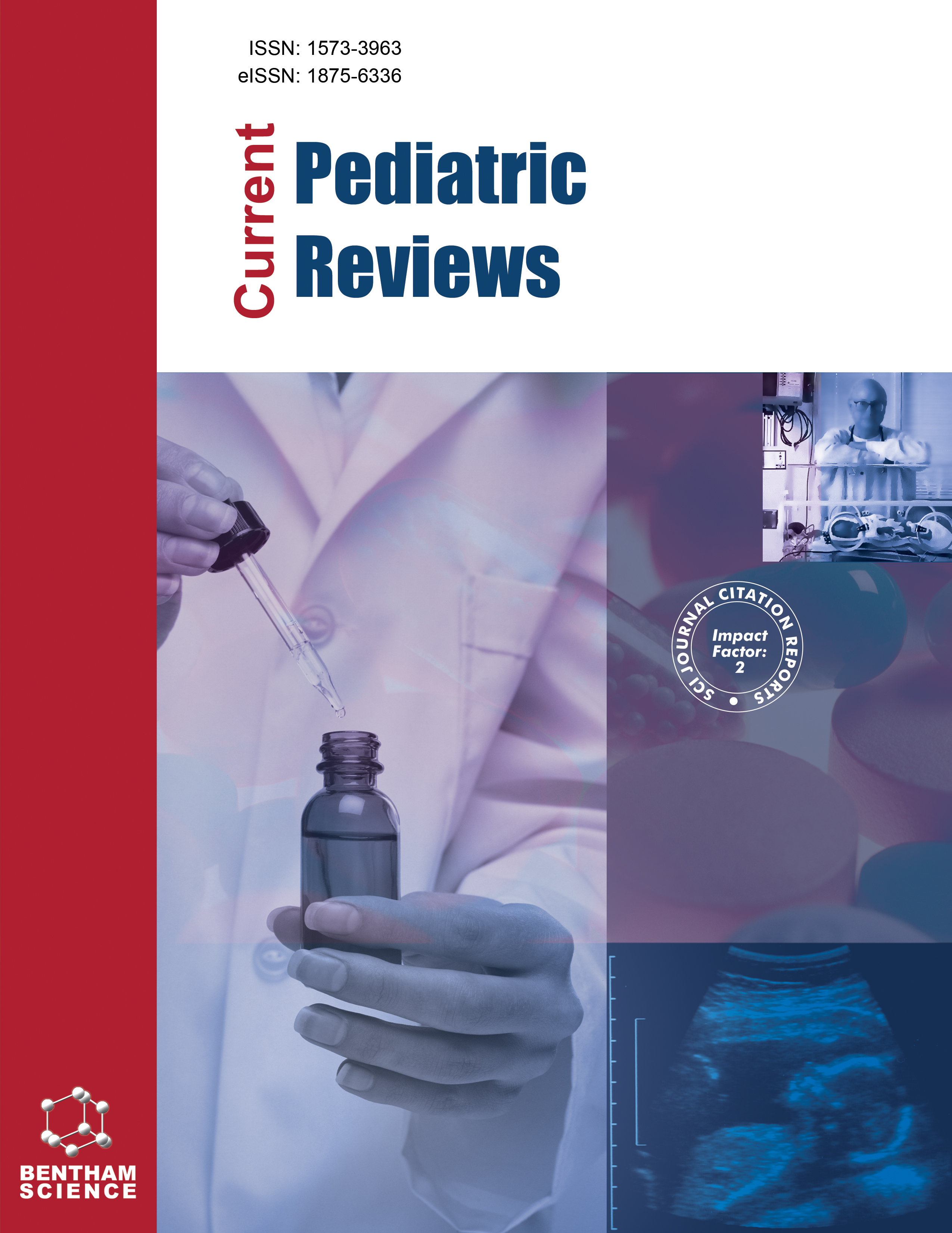- Home
- A-Z Publications
- Current Pediatric Reviews
- Previous Issues
- Volume 14, Issue 4, 2018
Current Pediatric Reviews - Volume 14, Issue 4, 2018
Volume 14, Issue 4, 2018
-
-
Neonatal and Long-Term Consequences of Fetal Growth Restriction
More LessAuthors: Marina Colella, Alice Frérot, Aline R. B. Novais and Olivier BaudBackground: Fetal Growth Restriction (FGR) is one of the most common noxious antenatal conditions in humans, inducing a substantial proportion of preterm delivery and leading to a significant increase in perinatal mortality, neurological handicaps and chronic diseases in adulthood. This review summarizes the current knowledge about the postnatal consequences of FGR, with a particular emphasis on the long-term consequence Read More
-
-
-
Preterm Birth: Long Term Cardiovascular and Renal Consequences
More LessAuthors: Hassib Chehade, Umberto Simeoni, Jean-Pierre Guignard and Farid BoubredBackground: Cardiovascular and chronic kidney diseases are a part of noncommunicable chronic diseases, the leading causes of premature death worldwide. They are recognized as having early origins through altered developmental programming, due to adverse environmental conditions during development. Preterm birth is such an adverse factor. Rates of preterm birth increased in the last decades, however, with the im Read More
-
-
-
The Therapeutic Potential of Stem Cells for Bronchopulmonary Dysplasia: “It’s About Time” or “Not so Fast” ?
More LessAuthors: Mong T. Ee and Bernard ThébaudObjective: While the survival of extremely premature infants has improved over the past decades, the rate of complications – especially for bronchopulmonary dysplasia (BPD) – remains unacceptably high. Over the past 50 years, no safe therapy has had a substantial impact on the incidence and severity of BPD. Methods: This may stem from the multifactorial disease pathogenesis and the increasing lung immaturity. Read More
-
-
-
Hydrops Fetalis and THE Parvovirus B-19
More LessAuthors: Emmanuel N. Kontomanolis and Z. FasoulakisDefinition: Hydrops Fetalis (HF) or fetal hydrops is identified as an abnormal interstitial collection of fluid in at least 2 or more compartments of the fetal torso (peritoneal cavity, pleura, and pericardium). An alternative definition discusses about liquor accumulation in two fetal anatomical areas or an effusion in one site and anasarca. Background: Parvovirus B-19 is a common childhood illness; the virus can cause fetal anemia, n Read More
-
-
-
A Cross-sectional Study of Two Chemotherapy Protocols on Long Term Neurocognitive Functions in Egyptian Children Surviving Acute Lymphoblastic Leukemia
More LessIntroduction: Subtle neurocognitive deficits have been recently observed in Acute Lymphoblastic Leukemia (ALL) survivors. Aim: We aim to assess the neurocognitive functions of ALL survivors who had been treated with chemotherapy only using two different protocols, and to identify treatment-related risk factors. Patients and Methods: We carried a multicenter study involving 3 pediatric oncology centers on 100 childr Read More
-
-
-
Iron Bisglycinate Chelate and Polymaltose Iron for the Treatment of Iron Deficiency Anemia: A Pilot Randomized Trial
More LessBackground: Iron Deficiency Anemia (IDA) is a major public health problem worldwide. Iron Bisglycinate Chelate (FeBC) and polymaltose iron (FeP) are used for the treatment of IDA and exhibit good tolerability with a low incidence of adverse effects. However, these compounds have important differences in their structures and bioavailability. Objective: To compare the efficacy of oral supplementation with FeBC and FeP in anemi Read More
-
Volumes & issues
-
Volume 21 (2025)
-
Volume 20 (2024)
-
Volume 19 (2023)
-
Volume 18 (2022)
-
Volume 17 (2021)
-
Volume 16 (2020)
-
Volume 15 (2019)
-
Volume 14 (2018)
-
Volume 13 (2017)
-
Volume 12 (2016)
-
Volume 11 (2015)
-
Volume 10 (2014)
-
Volume 9 (2013)
-
Volume 8 (2012)
-
Volume 7 (2011)
-
Volume 6 (2010)
-
Volume 5 (2009)
-
Volume 4 (2008)
-
Volume 3 (2007)
-
Volume 2 (2006)
-
Volume 1 (2005)
Most Read This Month
Article
content/journals/cpr
Journal
10
5
false
en


